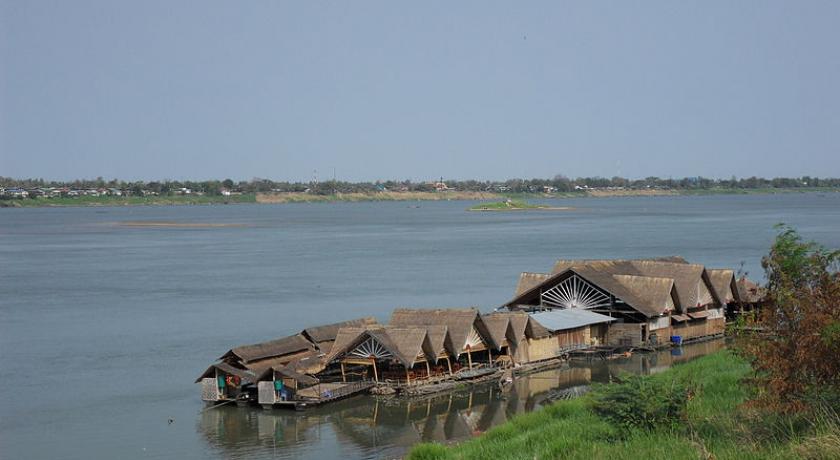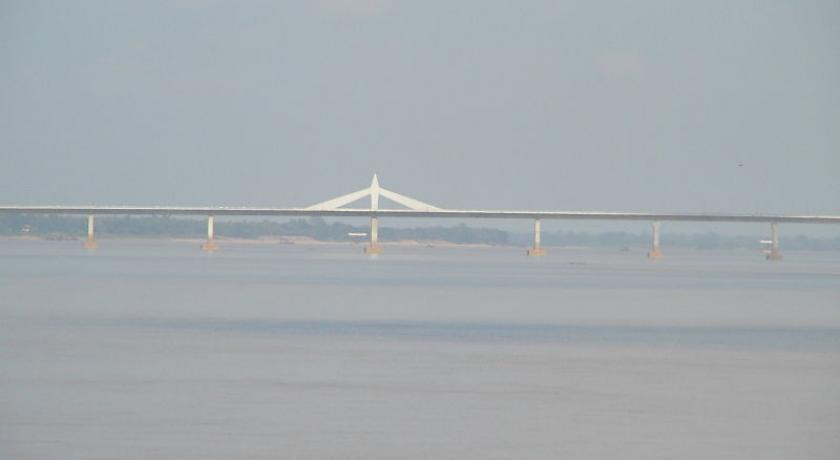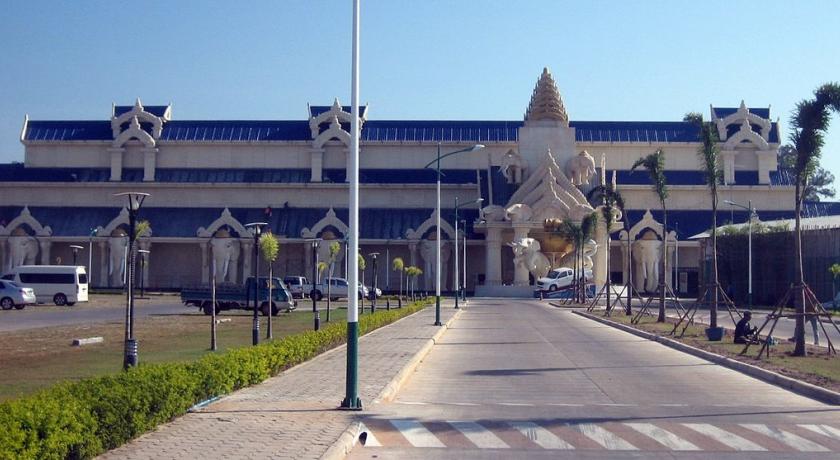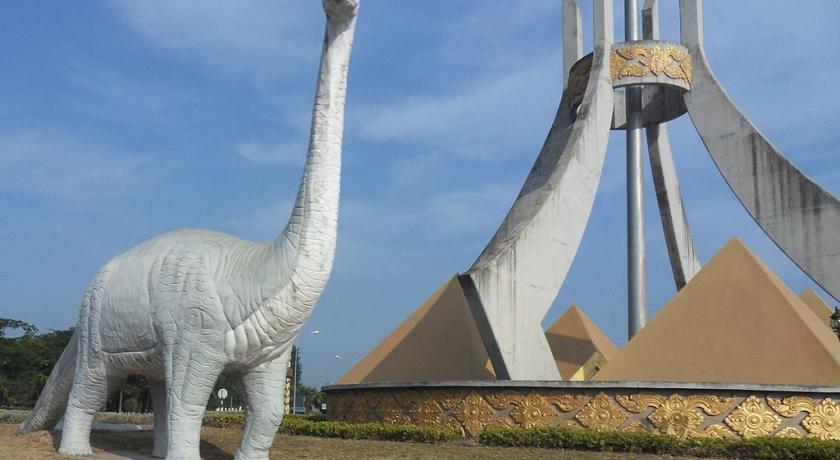Description
Savannakhét (Lao:ສະຫວັນນະເຂດ) is a province of Laos. The name derives from Savanh Nakhone ("city of paradise" or "land of fertility suitable for agriculture") the province's original name. It bears the same meaning as Nakhon Sawan, a city in Thailand.
The province is located in the southern part of the country and is the largest province in Laos. It borders Khammouane Province to the north, Quảng Trị and Thừa Thiên–Huế provinces of Vietnam to the east, Salavan Province to the south, and Nakhon Phanom and Mukdahan provinces of Thailand to the west. The Second Thai–Lao Friendship Bridge over the Mekong connects Mukdahan Province in Thailand with Savannakhet in Laos. Its capital, Savannakhet, also known as Kaysone Phomvihane or Muang Khanthabouly is Laos' second most notable city after Vientiane. It forms an important trading post between Thailand and Vietnam.
Along with Bolikhamsai and Khammouane, Savannakhét Province is one of the main tobacco producing areas of Laos. It has numerous natural resources. Sepon is the largest mine in Laos, with reserves of copper and gold.
History
Prehistoric human occupation is evidenced by the first stone tools in the province, dating back between 100,000 and 12,000 years. The first bronze tools date to 2000 BCE. The region was then the center of the Sikhottabong Kingdom. The much-venerated Pha That Sikhottabong stupa is situated on the grounds of a 19th-century monastery in Thakhek. Sikhottabong was an important kingdom in ancient Indo-China. Its capital was in the north-west of the province, in the present village of Meuang Kabong, on the eastern shores of the Banghiang River, about 10 kilometers (6.2 mi) east of the Mekong. Other centers of the kingdom were in Viang Chan, Khammuan, Nong Khai, and Udon. Khmer Empire ruins dating to AD 553 and 700 have been found at Heuan Hin.
In the 20th century, Savannakhet province was one of the seats of the struggle for independence. Prime Minister Kaysone Phomvihane originated in the province. The town was bombed and then occupied by Thai armed forces during the Franco-Thai War. During the Vietnam War, the eastern part of the province was crossed by the Ho Chi Minh trail. It was heavily bombed by U.S. forces and loyalists. Some areas are still under the threat of unexploded ordnance. In 2007, the Second Thai–Lao Friendship Bridge was opened across the Mekong from Savannakhet to Mukdahan, Thailand. In April 2008, a chance discovery was made at Meuang Kabong consisting of 8.5 kilograms (19 lb) of gold and 18.7 kilograms (41 lb) of silver objects, as well as pillars and traces of brick walls. Many missionaries came here; a Catholic church is located in Savannakhet.
Geography
Savannakhet Province one of the province of Laos, is the largest province, covering an area of 21,774 square kilometers (8,407 sq mi). The province borders Khammouan Province to the north, Quảng Trị and Thừa Thiên–Huế provinces of Vietnam to the east, Salavan Province to the south, and Nakhon Phanom and Mukdahan provinces of Thailand to the west. Notable settlements in the province include Savannakhet, Muong Song Khone, Ban Nhiang, Seno, Dong-Hen, Muang Phalan, Ban Sanoun, Muang Phin, Ban Dong, Ban Nammi, and Ban Nao Tai.
The Second Thai–Lao Friendship Bridge over the Mekong connects Mukdahan Province in Thailand with Savannakhet in Laos. The bridge is 1,600 meters (5,200 ft) long and 12 meters (39 ft) wide, with two traffic lanes
Protected areas
Areas under protection in the province include Xe Bang Nouan National Biodiversity Conservation Area to the south, Dong Phou Vieng National Protected Area to the southeast, and Phou Xang He National Protected Area to the north. Phou Xang He has rocky mountain ranges, and is known for local Puthai culture. The Dong Phou Vieng is known for its ancient forest with tall vegetation, a sacred lake and That Ing Hang Stupa; there are endangered Eld's deer, silver langurs and hornbills which are rarely found in other reserves.
Demographics
The population of this largest province of Laos is 825,879 as of the March 2005 census, spread over 15 districts. The ethnic minority groups residing in the province include Lao Loum, Phu Tai, Tai Dam, Katang, Mongkong, Vali, Lavi, Souei, Kapo, Kaleung and Ta Oi. However, in the 2000 census, only three ethnic groups were listed: Lao Loum (Lowland Lao), Phu Tai, and Bru, the only ones recognized by the provincial government. The Bru, however, are a diverse people with various dialects and cultures.
Economy
The Sepon Mine, situated about 250 miles (400 km) southeast of Vientiane, is the largest mine in Laos, with reserves of copper and gold. In the 1980s, Laotians panned for gold here using pieces of shrapnel and aircraft wreckage. Early exploration occurred in 1990 by Australian mining company CRA, which was subsequently awarded a contract. It is now operated and 90% owned by MMG Limited. Sepon became the country's first significant foreign mining interest when it opened in 2002. Other mining companies operating in the province (2008) include: Wanrong Cement III, Lane Xang Minerals LTD (Vilabuly District), Lane Xang Minerals Ltd (Vilabuly District), Lao State Gypsum Mining Co Ltd (Champhone District), and Savan Gypsum Mining Co. (Champhone District). Along with Bolikhamsai and Khammouane provinces, it is one of the main tobacco producing areas of Laos.
Landmarks
Apart from the provincial capital, Savannakhet, which is a trading centre opposite to Mukhdahan town in Thailand, other places of interest in the town area are the Roman Catholic Church, a Vietnamese temple and school. Most of the buildings in the town are in the French architectural style of their colonial rule. In the Ban Nonglamchan Village in Champhone District, there is a library which contains a collection of manuscripts written in the Kham-Pali and Lao languages on palm leaves which are stated to be 200 years old. In Ban Tangvay Village of Xonbuly District, fossilized dinosaur bones found in 1930 are exhibited in the Dinosaur Exhibition Hall in Savannakhet. The Ho Chi Minh trail and remnants of American tanks and warplanes are on display in Phin District on Route 9, near the Lao Bao border check post.
Fossil sites
There are five fossil sites in the province. The best known of the Cretaceous fossil sites is that of Tang Vay, 120 kilometers (75 mi) northeast of Savannakhet, which dates to 110 million years ago. The site was discovered by the geologist Josué Hoffet in 1936 and was explored by a team led by Philippe Taquet from the Muséum national d'histoire naturelle of Paris in the 1990s. He discovered tree fossils (Araucarioxylon hoffetti), turtles, and a sauropod, Tangvayosaurus hoffetti. Aptian age findings include a Psittacosaurus. In Pha Lane, on the banks of the Sê San River, a theropod was discovered.
Museums
Fossils are exhibited in a dinosaur museum in Savannakhet. The Savannakeht Provincial Museum has exhibits of war relics, artillery and inactive UXOs. Museum exhibits include three small bowls (diameter 50 centimeters (20 in)) and two large (diameter of 1 meter (3 ft 3 in) or more), seriously damaged but decorated, discovered in the district of Sepon (2001) and along the banks of the Mekong (2008). Their handles imitate basketry. The Dong Son culture is represented by several bronze drums.
Religious sites
The Wat Inghang temple, about 2000 years old, is located in the Ban Thad village. It was built to commemorate a visit of Lord Buddha when he was the guest of King Sumitatham of the Sikhottabong Kingdom. King Saysethathirath had the temple remodeled during 1548. It is approached by Route 9 between Savannakhet and Seno. An annual festival is held here on the first full moon of the lunar calendar.
The Wat Xayaphoum temple was built in 1542 in Xayaphoum village on the bank of the Mekong River during the period when Ban Thahir or Nakham temple was built. As the Buddhist centre and largest monastery in Laos, its arts and architecture are dated to the earliest Savannakhet period. The temple has a large garden with ancient trees surrounding it. There is also a workshop near the entrance from the river side where golden Buddha statues are made. Pimai Lao festival is held in the province and boat racing is an important event.
Heuan Hin ("stone house") is a shrine in Ban Dongdokmay. It was built during the Khmer regime in honour of their Sikhottabong Kingdom. The stone house is located 15 kilometers (9.3 mi) from Xayphouthong District, or 66 kilometers (41 mi) from Khanthabuly.
The That Phon Stupa was built during the period of 557 to 700. The festival held here during the first full moon of the lunar calendar marks tribute to Phra Sghiva and some Hindu gods.
St Teresa's Catholic Church is situated in Savannakhet's main square. Built in 1930, it consists of thick masonry walls and an octagonal spire.
Get in
By plane
Savannakhet has an airport. Lao Airlines is the only domestic carrier, and provides direct flights from and to Vientiane. Alternatively, Vientiane can be reached by flying via Pakse, a trip that takes two and half hours. One way to Vientiane costs around $US110, and round trips around double.
- The only domestic direct flight is to Pakse. It leaves Savannakhet at 15:00 and arrives at 15:35 three days a week: Sunday, Wednesday and Friday. At the same days there are flights from Pakse to Savannakhet, leaving 09:25 and arriving 10:00. As schedules might change suddenly it is recommended to contact Lao Airlines in advance.
- On Wednesday, Friday and Sunday, Lao Airlines also offers direct flights from/to Bangkok Suvarnabhumi Airport, taking 2 hours and 20 minutes. Leaving Savannakhet at 10:40. Flights from Bangkok leave at 13:00. One way trip costs around US$115, with a round trip twice that.
- Alternatively, from Bangkok, Nok Air offers three daily flight+minivan services from Bangkok to Mukdahanv; which is opposite to Savannakhet, travelers can cross the border to Savannakhet. This service include a flight with Nok Air from Bangkok to Nakhon Phanom/Ubon Ratchathani/Sakhon Nakhon) and transferred on a minivan to Mukdahan taking approximately 3-4 hours. This can be booked directly from their website.
By bus
- There is bus service from Vientiane to Savannakhet. It is a 9 hour paved road bus ride. While a long journey, it is an excellent way to see the local villages and lush country side of Laos. Buses from Vientiane to Pakse, stop either in Savannakhet or Seno. There are two different types of buses that service the route from/to Vientiane:
- Local Bus - The public bus leaves Vientiane and Savannakhet throughout the morning, and makes lots of stops to for both passengers and goods. Takes approximately 9 hours, costs 75,000 Kip one way. A genuine experience of Laos. If you take your bicycle on the Bus, it will be transported on the roof and costs 25,000 Kip extra.
- VIP Bus - much like the local bus, but there are less stops, assigned seats, there is a toilet and all important air conditioning. Less frequent and costs more, but it's worth it. The journey takes approximately 8 hours. There are two types of night buses: one with bunk beds (120,000 kip) and one with seats (110,000 kip). Each bunk bed accommodates two people - it's recommend to buy the space next to you if you are traveling alone or traveling in odd numbered groups as you will be sleeping next to a stranger in a twin-sized bed.
There are also local buses from and to:
- Thakhek (30,000 kip, 2-3 hours)
- Pakse (50,000 kip, 5-7hours you will probably need to change as well)
- Si Pham Don (75,000 kip, 7 hours)
- There are direct local buses from and to less traveled domestic destinations, such as Sekong (60,000 kip, 5 hours), Salavan (via Pakse, 60,000 kip, 8 hours), Attapeu (70,000 kip, 10 hours) and Sepon (40,000 kip, 4-5 hours).
- For locals, a tuk-tuk to the bus station from the town centre costs 5,000 kip, for foreigners it's more likely to cost between 10,000 and 15,000 kip per person.
- The Savannakhet bus station is located ~2 km north of the old town centre (16.5752 104.7525). ~50b for a tuk tuk rider into the city.
International
- The Second Thai–Lao Friendship Bridge across the Mekong to Mukdahan, Thailand opened to the public in January 2007. There is a regular bus service between Mukdahan and Savannakhet, with departures approximately twice an hour. A one way trip between Savannaket and Mukdahan costs around 50 baht or 14,000 kip. If you have to obtain a tourist visa at the Laos immigration, ask the bus driver to wait as otherwise they won't.
- Daily buses make the five hour trip (35,000 kip) from / to the Lao Bao border in Vietnam via Sepon. Local bus 07:30am, 09:00 and 12:00.
- VIP buses to Dong Ha in Vietnam go via Lao Bao, and are only available on weekdays at 10:00. The 350 km trip takes around seven hours and costs 90,000 Kip. Local buses leave every day at 10:00 80,000 kip) and take seven hours.
- VIP buses to Hue (Vietnam) leave on weekdays only at 9am. The 410 km journey takes eight hours and costs 110,000 kip. Get information and your reservation at Savanbanhao hotel. The local daily bus to Hue (leaving 10:00, 90,000 kip) is not recommended as you need to wait at the border checkpoint from 03:00 until the checkpoints opens at 08:00, which will lead to insufficient night rest due to immigration officials, vendors and beggars trying to get your money. For local buses to Danang (also Vietnam) the same details apply.
Get around
The easiest way to get around Savannakhet is by foot or bicycle. Tuk-tuks are also available around the city and are an easy way to get quickly to a specific location. Be cautious about the fee for the tuk-tuk, and always set the price in advance. Because the minor roads of the districts around Savannakhet are often badly paved, a reliable cheap motorbike for rent in Savannakhet town might be hard to find.
See
- The Tourist Information office is located between the Mekong riverside and the 'Plaza', the central square of the French historical town. A must visit for those wishing to see the city/area. The office offers many different local walking tours as well as a wide variety of eco tours. They also have a comprehensive free map of the city (extremely important). The staff is attentive and speaks English well. Lin's café (100m north of the same Plaza) is connected to the Tourist Information and offers the same service. The office is closed at the weekend!
- That Ing Hang Stupa - 5,000 kip. This 16th century stupa is one of the most revered in the country of Laos. Each year in December, many Buddhists travel to this holy site for the annual 'Boun Pha' ceremony. It is located 13 km north-east of Savannakhet. There are two roads that lead to the stupa: the first one is the busy main road to Seno. Tuk Tuk rides should cost 70,000 kip for a round-trip. Far more recommended is the alternative road through the green rural outskirts, passing the Beung Va lake, which is best experienced by bicycle or motorbike.
- Kaysone Phomvihane's House Part of the Historic tour. See the former Laotian leader's residence.
- Wat Xayaphoum - a 16th century temple located in the centre of the city along the bank of the Mekong River. Now serving as both temple and high school for novice monks of Savannakhet. Pee Mai Lao (The Lao New Year celebration) and Boun Suang Huea (boat racing festival) following Buddhist Lent are held here.
- Dinosaur Museum - 10,000 kip. Exhibits dinosaur fossils or 'big lizard bones' as called in Lao. They were excavated from Xonbouly District. Three kinds of dinosaur bones have been discovered; Pode, Iguanodon and Sauropode. It's likely a staff member will show you around and explain the exhibits to you. If you're lucky he'll even take you out the back and show you a pair of French scientists cleaning (?!) a (more or less) complete skeleton. Strangely, photos aren't allowed of them working. The museum opens daily from 08:00-11:30 and 13:30-16:30.
- Old French colonial buildings. Old French Style buildings can be seen in the central city area, especially around the Catholic Church and the central plaza. These building are heritages from the French colonization of Laos in the mid 20th century. You can find a free exhibition about this history on the 2nd floor of Lin's cafe.
- UXO SVK is the abbreviation of 'Unexploded Ordnance Savannakhet', an American/Lao organisation. The exhibition found at their office intends to raise awareness among the citizens of Savannakhet, who generally spoken don't care much (not even know) about the severe UXO problems in the Eastern side of their province, which was heavily bombed during the Vietnam war. A lot of UXO accompanied with photographs and information about demining projects can be found here. There is English reading material available as well. Located south-east of town at Makhaveha rd, next to Mama's Home restaurant.
Do
- Swimming Pool - As temperatures may get really high in Savannakhet, a swim in the public swimming pool among local children and teenagers is fun, cooling and therefore recommended. On the main road near Nan Hai hotel. Price for foreigners 30,000k in Febr. 2013.
- Savannakhet Tennis Club - (on Khantabuli Road) While the tennis clubhouse may look it needs upgrading, the three courts are in good condition. Court fee is 20,000 kip. Bring your own racquets.
- Eco-tourism treks advertised in most guesthouses are fantastic. Homestays, forest food, school visits, local guides, etc... Highly recommended. The eco centre has one, two and three day treks. Some of which include visits to the Ho Chi Minh trail and to see the Dinosaur Footprints.
- As part of eco-trekking, or just discovered on your own, explore Dong Natad Forest, a 'Provincial Protected Area' which extends to 8,300 hectares and hosts two tribal villages. There is a beautiful lake called 'Nong Lom' in the centre of the forest where you can observe wild birds like teal, butterflies and rare plants. The entrance of the forest is near the That Ing Hang stupa.
- Lao Massage one hour for 35,000 kip at Dok Champa Khao on the main street. A clean, discreet and welcome place comfortable for Westerners. Excellent after a trek.
- Just relax in some of the cheap cafes around, maybe rent a bike and explore this little French colonial town. In the evening catch a beer by the river and take some time out from the road.
- Urban teenagers depend on foreigners to practice and improve their English skills. Don't hesitate to visit a classroom and have a chat in either the Sangha High School at Wat Xayaphoum (on Mekong riverbank) or the TTC (Teacher Training College), which is five km out of town along the road to Seno.
- Visit the Eye Hospital Savannakhet, located next to Wat Ponsavangthai. Meet the English speaking eye doctors, bring your collected spectacle frames or financially support cataract surgery for the people of the countryside. Part of this hospital is a vocational center and home of ten blind people who offer Lao Massage for 25,000 kip (1h30min).
- Historic Exhibition, Latsaphanit rd,Tel +856 20 9988 1630. 08:30-20:00. Located on the second floor of Lin's Café, this is a private exhibition about the history of the French colonial architecture of the town centre area. Free.
- Take a Walking History Tour Lin's Cafe (which is part of the circuit) has a pamphlet that gives you the history of some of Savannakhet's historic buildings. This is easily done in a few hours with a bicycle or on foot and gives you a good idea of the richness and cultural diversity of Savannakhet's architectural history.
- Savan Vegas Casino, Nongdeune Village, Kaishonephomvihan District, Tel 041 252 200. 24/7. Savan Vegas Hotel & Casino has more than 500 slots, 100 table games and sport betting facilities.
Events
That Phon Festival
Boun Pha That Phonh is a festival taking three days and three nights, held at full moon in February at That Phon, a sacred stupa in Phon Village. There are different exhibitions of traditional goods, sports, dance, songs, etc. Local people offer rice balls to the stupa and local monks.
Heuan Hin Festival
Boun Heuan Hin is a festival held at Heuan Hin ('Stone House') in the middle of March, another important sacred place, dating back to Khmer Empire. This annual festival is organised to respect ancestors. As part of the ceremony Buddhist monks make offerings to the persons that built the Stone House. Visitors enjoy shopping of local products. At night there is a traditional dance called lamvong, where men and women dance together in a big circle.
Lao New Year Festival
Boun Pee Mai Lao. This festival is held all over Laos, from 14-16 April. It celebrates the passing of the old year and welcoming the new. In Savannakhet the biggest festivals are held in the city. There is a Miss Lao New Year contest; the winner parades through the town on the back of an artificial animal. Some families organize baci ceremonies, big arches made of rice plants in order to show their respect to the earth and sky spirits as well as to the land spirits who facilitate rice production. People splash or pour fragrant water with flowers to other people passing by, to wash bad things out from their bodies.
Rocket Festival
Bounpavet (Elephant Parade) and Boun Bangfai (Rocket Festival) are held in Champhone district (55 km from Savannakhet) at the end of April to early May. There are many activities including traditional dancing, artificial elephant and horse riding and men wearing traditional Lao women clothes and cosmetics. Each village prepares a rocket and a rocket competition is held. The village with the highest rocket launch, wins. This competition is held for showing appreciation to thePayathan, deities who give rain for successful agriculture.
Boat Racing Festival
Boun Suang Heua is annually organized to express people's appreciation to the Mekong River as source of their life. It is held at mid October, at the last full moon of the Buddhist Lent (rains retreat). The ceremonies take place at the Mekong River bank and each temple. Vat Xayaphoum is the main temple. People make Kathin offerings to the temples and temple parades and traditional dances are organized. Long boats, made out of bamboo and banana trees, are filled with offerings like cakes, foods, flowers and candles. On the first day around 11:00 a boat racing ceremony starts at the river bank. Prior to this race, Lao and Thai river banks welcome each other’s boats.
Ing Hang Stupa Festival
In December, Boun Pha That Ing Hang is visited by people from all over Laos and Thailand. This festival is organized to show respect to Buddha and the people who built the stupa. People make offerings, Khanmarkbeng, bringing flowers and small towers made of banana leaves. Nuns who are around the stupa are available to give blessings by tying cotton strings around the visitor’s wrists.
Source https://en.wikipedia.org/wiki/Savannakhet_Province
Address
Savannakhet Province
Laos
Lat: 16.506538391 - Lng: 105.594337463







